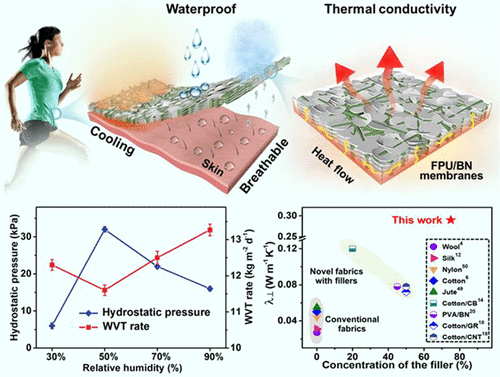当前位置:
X-MOL 学术
›
ACS Appl. Mater. Interfaces
›
论文详情
Our official English website, www.x-mol.net, welcomes your feedback! (Note: you will need to create a separate account there.)
Thermoconductive, Moisture-Permeable, and Superhydrophobic Nanofibrous Membranes with Interpenetrated Boron Nitride Network for Personal Cooling Fabrics.
ACS Applied Materials & Interfaces ( IF 8.3 ) Pub Date : 2020-07-01 , DOI: 10.1021/acsami.0c04486 Xi Yu 1 , Yang Li 2 , Xianfeng Wang 1, 2 , Yang Si 1, 2 , Jianyong Yu 1, 2 , Bin Ding 1, 2
ACS Applied Materials & Interfaces ( IF 8.3 ) Pub Date : 2020-07-01 , DOI: 10.1021/acsami.0c04486 Xi Yu 1 , Yang Li 2 , Xianfeng Wang 1, 2 , Yang Si 1, 2 , Jianyong Yu 1, 2 , Bin Ding 1, 2
Affiliation

|
Space cooling occupies a large portion of total building energy consumption, aggravating the energy crisis and restricting human sustainable development, thus an efficient and energy-saving personal cooling technology is in high demand. Recently, thermally conductive fillers, such as boron nitride (BN), are usually enriched to fibrous materials to construct thermal management textiles. However, these fabrication processes are complex and time-consuming, and the resultant materials fail to transmit moisture and resist liquid water. Herein, we develop a facile and scalable methodology to construct highly thermoconductive breathable superhydrophobic nanofibrous membranes to enhance the thermal management of textiles for personal cooling. The strategy causes boron nitride (BN) to be linked with each other along nanofibers, and thus the membranes contain well interpenetrated BN network and remain porous structure simultaneously, improving their thermal conductivity without sacrificing the moisture permeability. In addition, the membranes possess good resistance to water penetration and intriguing superhydrophobicity due to the synergistic effect of the hydrophobic polymeric matrix and improved roughness. As a consequence, the resultant membranes demonstrate outstanding hybrid active-passive cooling performance with ultrahigh in-plane thermal conductivity of 17.9 W m–1 K–1, cross-plane thermal conductivity of 0.29 W m–1 K–1, and high water vapor transmission (WVT) rate of 11.6 kg m–2 day–1, as well as excellent water repellency with water contact angle of 153° and high hydrostatic pressure of 32 kPa, indicating promising utility for the next generation of cooling fabrics.
中文翻译:

具有互穿氮化硼网络的导热,透湿和超疏水纳米纤维膜,用于个人凉爽面料。
空间制冷在建筑能耗中占很大比重,加剧了能源危机,限制了人类的可持续发展,因此对高效节能的个人制冷技术提出了很高的要求。近来,通常将诸如氮化硼(BN)之类的导热填料富集到纤维材料中以构造热管理纺织品。然而,这些制造过程是复杂且费时的,并且所得材料不能传递水分和抵抗液态水。在本文中,我们开发了一种简便且可扩展的方法来构建高度导热的透气超疏水纳米纤维膜,以增强用于个人冷却的纺织品的热管理。该策略使氮化硼(BN)沿着纳米纤维相互连接,因此,该膜具有良好的互穿性BN网络,同时保持多孔结构,从而在不牺牲透湿性的情况下提高了其导热性。另外,由于疏水性聚合物基体的协同作用和改善的粗糙度,该膜具有良好的耐水渗透性和令人着迷的超疏水性。结果,所得的膜表现出出色的混合主动-被动冷却性能,超高面内导热率为17.9 W m 由于疏水性聚合物基体的协同作用和改善的粗糙度,该膜具有良好的耐水渗透性和令人着迷的超疏水性。结果,所得膜表现出出色的混合主动-被动冷却性能,超高面内导热系数为17.9 W m 由于疏水性聚合物基体的协同作用和改善的粗糙度,该膜具有良好的耐水渗透性和令人着迷的超疏水性。结果,所得的膜表现出出色的混合主动-被动冷却性能,超高面内导热率为17.9 W m–1 K –1,跨平面导热系数为0.29 W m –1 K –1,高水蒸气透过率(WVT)为11.6 kg m –2天–1,并且具有出色的防水性和水接触角153°的高静水压和32 kPa的高静水压力,表明可用于下一代冷却织物。
更新日期:2020-07-15
中文翻译:

具有互穿氮化硼网络的导热,透湿和超疏水纳米纤维膜,用于个人凉爽面料。
空间制冷在建筑能耗中占很大比重,加剧了能源危机,限制了人类的可持续发展,因此对高效节能的个人制冷技术提出了很高的要求。近来,通常将诸如氮化硼(BN)之类的导热填料富集到纤维材料中以构造热管理纺织品。然而,这些制造过程是复杂且费时的,并且所得材料不能传递水分和抵抗液态水。在本文中,我们开发了一种简便且可扩展的方法来构建高度导热的透气超疏水纳米纤维膜,以增强用于个人冷却的纺织品的热管理。该策略使氮化硼(BN)沿着纳米纤维相互连接,因此,该膜具有良好的互穿性BN网络,同时保持多孔结构,从而在不牺牲透湿性的情况下提高了其导热性。另外,由于疏水性聚合物基体的协同作用和改善的粗糙度,该膜具有良好的耐水渗透性和令人着迷的超疏水性。结果,所得的膜表现出出色的混合主动-被动冷却性能,超高面内导热率为17.9 W m 由于疏水性聚合物基体的协同作用和改善的粗糙度,该膜具有良好的耐水渗透性和令人着迷的超疏水性。结果,所得膜表现出出色的混合主动-被动冷却性能,超高面内导热系数为17.9 W m 由于疏水性聚合物基体的协同作用和改善的粗糙度,该膜具有良好的耐水渗透性和令人着迷的超疏水性。结果,所得的膜表现出出色的混合主动-被动冷却性能,超高面内导热率为17.9 W m–1 K –1,跨平面导热系数为0.29 W m –1 K –1,高水蒸气透过率(WVT)为11.6 kg m –2天–1,并且具有出色的防水性和水接触角153°的高静水压和32 kPa的高静水压力,表明可用于下一代冷却织物。















































 京公网安备 11010802027423号
京公网安备 11010802027423号